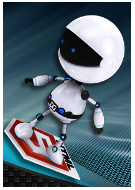Hop Aboard the Future Express

Therese Sullivan,
Principal,
www.buildingcontext.me
Contributing Editor
|
August 2014 |
[an error occurred while processing this directive] |
|
DGLux5 Training
Hop Aboard the Future Express
|
 Therese Sullivan, Principal, www.buildingcontext.me Contributing Editor |
| Articles |
| Interviews |
| Releases |
| New Products |
| Reviews |
| [an error occurred while processing this directive] |
| Editorial |
| Events |
| Sponsors |
| Site Search |
| Newsletters |
| [an error occurred while processing this directive] |
| Archives |
| Past Issues |
| Home |
| Editors |
| eDucation |
| [an error occurred while processing this directive] |
| Training |
| Links |
| Software |
| Subscribe |
| [an error occurred while processing this directive] |
 It’s easy to bat around the term “Internet of Things.” But
until you’re
in a room full of interface designers trying to make the implied
thousands and thousands of connections visible and manageable—you don’t
appreciate what it means. I came to this realization while attending
the 3-day DGLux5 Introductory training course last week near San
Francisco. It’s also now clear why the DGLogik brand mascot is a
futuristic space-traveler: the DGLux5 users in that room were well on
their way to defining how building operations will be accomplished
tomorrow.
It’s easy to bat around the term “Internet of Things.” But
until you’re
in a room full of interface designers trying to make the implied
thousands and thousands of connections visible and manageable—you don’t
appreciate what it means. I came to this realization while attending
the 3-day DGLux5 Introductory training course last week near San
Francisco. It’s also now clear why the DGLogik brand mascot is a
futuristic space-traveler: the DGLux5 users in that room were well on
their way to defining how building operations will be accomplished
tomorrow.
This training session attracted a representative cross-section of the
buildings industry from energy consultants, to lighting control
application developers, to HVAC specialists and system integrators of
all levels. Some were brand new to the DGLux platform and others were
making the transition from the previous version of the software to new
DGLux5. Led by Arthur Alter, DGLogik VP of Business
Development,
the class covered fundamental design tools and the intelligent elements
that make it possible to quickly filter data flows from disparate
system sources and deliver a desired result to the end user’s phone,
tablet or desktop screens.
I can attest that the platform can make interacting with a smart
building’s vast data resources push-button simple, having seen some of
my classmates’ existing projects. However, delivering this simplicity
to the customer requires a non-trivial level of skill and aptitude on
the part of the dashboard designer/application developer. Others
in the room came to class with years of experience in HVAC, lighting,
security, energy and, in some cases, ‘all of the above,’ and they also
seemed to be masters of the IT concepts that underlie spreadsheets,
system management directories and computer graphics. The DGLux
development projects demo’ed for me were designed to pull real-time
data from hundreds of VAV boxes, multiple air handlers, as well as
other building resources such as physical access systems. Manipulating
all those streams is inevitably complex. DGLux mitigates this
complexity through its own graphical user interface that spares
developers the need to write and render lines of code. Whether you are
building a data flow diagram or a digital replica of an air handler,
you can complete most actions by selecting elements from libraries and
folders, dragging them onto the design stage and dropping them into
place. Intelligent elements and concepts, such as Bindings, Repeaters
and Relativization are indispensable when dealing with such large data
sets because they make bulk actions possible.
The concept of an ‘IoT Visualization Platform,’ as DGLux
is described,
is a recent innovation. You can understand its fast adoption by
considering an earlier visualization platform category—Electronic
Design Automation (EDA). EDA emerged when the components and wires that
comprised chip designs became so small and numerous that electronics
designers could only do their work via Computer-Aided Design (CAD)
graphics systems. It was adapt or change professions — the trend toward
miniaturization would never reverse. Similarly, the number of smart
devices in a building and their complex interdependencies is growing
beyond the capacity of human operators to keep in mind. So we’re
extending our capacity to visualize with 3D graphics. Here too,
there will be no going backwards. The type of real-time data-driven
imagery that a DGLux interface delivers is becoming essential to
managing the complexities of building operations. Building
automation and controls companies that understand this new reality are
investing now in the skills needed to create and maintain DGLux
dashboards and applications for their customers.
A DGLux application for monitoring an embedded-floor radiant cooling system in a data center."
Over
my three days of hands-on training, I definitely got the ‘Why’ of
DGLux. And, I even gained skill at the ‘How,’ despite the fact that it
was a first-time experience. I was more than inspired by others in
class that already had their HVAC monitoring, energy analysis, load
shedding and other projects in the field improving building
comfort and performance, while saving time and money. By necessity, the
class moved at a very fast clip, as there were so many product features
to cover. Importantly, I found the challenge of the HTML5 interface not
insurmountable, but rather fun. It’s a good thing, because I predict
that just about everyone in the controls industry is going to need to
be familiar with this technology sooner rather than later.

DGLogik's Arthur Alter
delivers training on the DGLux 5
IoT
Visualization platform at a 3-day session held near San Francisco, July
16th-18th.
[an error occurred while processing this directive]
[Click Banner To Learn More]
[Home Page] [The Automator] [About] [Subscribe ] [Contact Us]